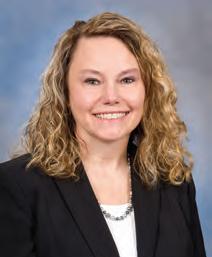Capital Credits
A sweet slice of money back!
A refreshing part of being a Blue Ridge Energy member is money back to you! It’s one of many delightful benefits of your cooperative membership. Turn the page for more juicy details.
OVER $6million back



Capital Credits
A sweet slice of money back!
A refreshing part of being a Blue Ridge Energy member is money back to you! It’s one of many delightful benefits of your cooperative membership. Turn the page for more juicy details.
OVER $6million back


Being an electric cooperative member has many benefits.
This month, members will get their slice of money back through capital credits. Those are members’ share of money left over after expenses have been paid and funds set aside for reliability projects and storm emergencies.
Nearly 94,000 active and inactive members will be receiving a total of over $6 million!
Active Blue Ridge Energy members receiving less than $100 will see a bill credit on their May electric statement. Those receiving $100 or more will receive a check in the mail.


Benefits continue even after you move or become inactive. By keeping your mailing address updated with us, you’ll continue to receive a capital credits check in the mail.
Those members who have not kept their mailing address updated and who have unclaimed capital credits are listed at BlueRidgeEnergy.com/Unclaimed. Please look for friends and family members on that list. Let them know and help add a special slice of sweetness to their lives, too.



For many patients with macular degeneration and other visionrelated conditions, the loss of central visual detail also signals the end to one of the last bastions of independence - driving. A Wilmington optometrist, Dr. Edward Paul, is using miniaturized telescopes which are mounted in glasses to help people who have lost vision from macular degeneration and other eye conditions.
“Some of my patients consider me the last stop for people who have vision loss” said Dr. Paul, one of only a few doctors in telescopes to help those who have lost vision due to macular degeneration, diabetic retinopathy, and other debilitating eye diseases.
Imagine a pair of glasses that can improve your vision enough to change your life. If you’re a low vision patient, you’ve probably not only imagined them, but have been searching for them. Bioptic telescopes may be the breakthrough in optical technology that will give you the independence you’ve been looking for. Patients with vision in the 20/200 range can many times be improved to 20/50.
Macular degeneration is the leading cause of blindness and vision loss in people over 50. Despite this, most adults are not
familiar with the condition. As many as 25% of those over the age of 50 have some degree of macular degeneration. The macula is only one small part of the retina, however it is the most sensitive and gives us sharp central vision. When it degenerates, macular degeneration leaves a blind spot right in the center of to recognize faces, read a book, or pass the driver’s vision test.
Nine out of 10 people who have macular degeneration have the dry form. New research suggests vitamins can help. The British medical journal BMC Ophthalmology recently reported that

A scene as it might be viewed by a person with age-related macular degeneration
56% of patients treated with a high-dose combination of vitamins experienced improved vision after six months.
TOZAL Comprehensive Eye Health
Formula is now available by prescription from eye doctors.
risk factor for developing the disease, heredity, smoking, cardiovascular disease, and high blood pressure have also
degeneration accounts for 90% of new legal blindness in the US. While there is currently no cure, promising research is being done on many fronts. “My job
possible to keep a person functioning” says Dr. Paul. Even if it’s driving.
Doreen Jenkins, 72, of Pocahontas,
friend. She wanted to keep her Iowa drivers license and was prescribed bioptic telelights farther away. Dr. Paul also prescribed microscope glasses for reading newspapers and menus in restaurants.
As Doreen puts it, “my regular glasses didn’t help too much- it was like looking through a fog. These new telescopic glasses not only allow me to read signs from a farther distance, but makes driving much easier. I’ve also used them to watch television so I don’t have to sit so close. I don’t know why I waited three years to do this; I should have come sooner.”
“Bioptic telescopes can cost over $2,000,” says Dr. Paul, “especially if we build them with an automatic sunglass.” -
scope is that the lens automatically focuses on whatever you’re looking at,” said Dr. Paul. “It’s like an self-focusing camera, but much more precise.”
To learn more about bioptic telescopes or to schedule a consultation with Dr. Paul, give us a call at 1-910-208-9011. You can also visit our website at:
www.LowVisionNC.com
(910) 208-9011

Dr. Edward Paul & Dr. Casey Krug Offices located in Wilmington, Asheville, and Charlotte

Experiencing a power outage? Please contact your electric co-op directly to ensure prompt service. Visit carolinacountry.com/co-ops to find yours online.

What’s North Carolina’s best museum? What minor league baseball team do you root for? Visit carolinacountry.com/finest and submit nominations in 10 categories by May 15 for a chance to win one of three $100 gift cards.
I just read your April article about Elvis’s visit to Lexington in 1956 (“Burnin’ Love, page 16). I was a junior at Lexington High School at that time, and myself and several buddies wanted to go see Elvis, but did not have tickets.
We were very familiar with the show site (the local YMCA) and asked a friend who had a ticket if he would unlock the window in the men’s restroom. He did, and we were able to enter through the window to see Elvis. It was standing room only, but we were able to go to the front of the stage and were only feet away from the “King.” Thanks for the memory.
Bill D., a member of Tideland EMC
We love talking about new technology that both you and your electric co-op can use to make life easier — and more energy efficient. While you may be using some of these at home, North Carolina’s farmers are also collaborating with electric co-ops to put energy efficient technology to work in the field. Read more on page 8. Also, have you ever been flummoxed by hundreds of little holes ravaging outdoor garden leaves? I know I have. According to L.A. Jackson, we may have flea beetles. Find out how to send the little guys packing on page 18.
—Scott Gates, editorREADER POLL
Summer Vacation: Where to?
With summer fast approaching, what’s your favorite vacation destination? Amusement parks, resorts, a beach trip, a staycation? (Or what vacation — you get a vacation?) Scan the QR code to answer our current social media poll, and follow us on Facebook, Instagram or X (formerly Twitter) to participate in future polls!





THEME
A Mother’s Love
A New kid on the block
Kimberly Farmer, Dobson
A member of Surry-Yadkin EMC
B Mother hen
Casey Hicks, Danbury
A member of EnergyUnited
C S-mooooo-ch
Shanna Stawicki , Swansboro
A member of Jones-Onslow EMC
D Boys love their mamas
Mae Spivey, Sanford
A member of Central Electric
E Mother-in-love
Lynda Holt, Dallas
A member of Rutherford EMC
SUBMIT YOUR PHOTO!
July Theme: Summer Road Trips
Send us your best shots based on the upcoming month’s theme by May 20 — we’ll pay $25 for those published. Submit high resolution digital photos and find full terms and conditions at carolinacountry.com/snapshots (no emails, please). We retain reprint and online rights for all submissions.
Digital Extra
Visit carolinacountry.com/extras for a DIY guide to crafting a meaningful Mother’s Day photo album.




Across the state and the entire country, the need for power is growing. Businesses and manufacturing are thriving. New, efficient technology — like electric vehicles (EVs) and electric heating and cooling systems — are becoming more accessible, and renewable energy and battery storage are growing. These are all good things — good things prompting significant changes in how and where electricity is generated, managed and yes, even consumed.
There is no “business as usual” in the electric utility industry, which has experienced predictability and a tried-and-true operating structure for decades. These big changes are prompting concerns about electric reliability from power grid watchdog groups, which I discussed in a column last summer (“Safeguarding Reliable Power,” July 2023, page 4), and the topic is often covered in the media.
Electric co-ops are stepping up to meet the changing needs of our members.
It’s also top-of-mind for consumers, with 87% of electric cooperative members in North Carolina expressing concern about grid reliability, according to the 2023 National Survey on the Cooperative Difference. But despite these big changes and the concerns they prompt, one thing that’s certain is our commitment to working ahead of these complexities to provide you with reliable and affordable power. North Carolina’s electric cooperatives are working together and are investing in technologies that support our evolving grid.
First, we are developing new programs and partnerships to manage grid resources more efficiently. These include coordination both within the electric co-op network and with other electric utilities to ensure demand is met across the entire power grid. On the consumer side, innovative programs enable co-ops to work directly with members to manage devices like water heaters and smart thermostats, reducing energy use when it’s most needed.
Second, North Carolina’s electric co-ops are adding resources to increase available power
while supporting our goal of net-zero carbon dioxide emissions by 2050. Recent examples include plans to partner with Duke Energy on its proposed hydrogen-capable natural gas plant in Person County (see page 6), as well as new renewable sources like solar + storage sites across the state, and additional energy storage projects at co-op substations.
Third, co-ops are focused on the future. We’re exploring and implementing concepts such as microgrids to further enhance local reliability. We’re also exploring the responsible use of artificial intelligence to improve forecasting that accounts for new technology trends — like widespread use of electric heat pumps — to help predict when demand will be high. And we’re storm-hardening systems, ensuring grid components work as they should and can operate at full capacity when needed.
The bottom line is electric co-ops aren’t doing business as usual. As we’ve done since the early days of rural electrification, we’re stepping up to meet the changing needs of our members, whether that means welcoming new electric load in homes, businesses and on farms across the state, or supporting economic development that can energize rural communities.
We’re approaching these and other initiatives with an overall strategy to ensure a brighter future — a reliable future — for North Carolina’s rural people and the communities we call home.
president of North Carolina Electric Membership Corporation. Susan Flythe is executive vice president and general manager at Cape Hatteras Electric Cooperative in Buxton. She currently serves asStarts 5/6/24 Easy to use. Easier to afford. New lower prices, same great phones.
Easy | Our easy-to-use Jitterbug® phones feature large screens, simple menus, powerful speakers and Urgent Response buttons. The Jitterbug® Flip2 has big buttons and one-touch speed dialing while the Jitterbug® Smart4 has voice typing, video chat and internet access.
Helpful |
Whether you want to learn more about your new phone, need a ride or have a health concern, we’re here to help. And when you add Urgent Response, enjoy peace of mind knowing you can count on us, even in an emergency. Our kind and knowledgeable, specially trained, 100% U.S.-based caring team listens and goes above and beyond in answering your questions.

Flexible, affordable plans as low as
• Unlimited Talk & Text
• 24/7 access to our caring team
• Fast, reliable nationwide coverage
• No long-term contracts
•
phone number4
Electric cooperatives remain focused on reliability, affordability through partnership North Carolina’s Electric Cooperatives, the Raleigh-based wholesale power provider and trade association for the state’s network of 26 electric distribution cooperatives, plans to partner with Duke Energy on its proposed hydrogen-capable natural gas plant in Person County.
“We are pleased to partner with Duke Energy on this flexible generation project,” said Amadou Fall, COO for North Carolina Electric Membership Corporation (NCEMC), the wholesale power supply arm for 20 of North Carolina’s electric distribution cooperatives.
As announced by Duke Energy, this project, called the Person County Energy Complex, is a critical piece of the energy transition away from coal to a source of generation that emits less than half the emissions of coal.
“Our participation in this project will allow us to uphold our long-term commitments of providing reliable electricity at the lowest possible cost, while also working toward an important sustainability goal of net-zero carbon emissions by 2050,” said Fall. “Not only is natural gas a cleaner source of generation, but it is also an important complement to renewable energy growth in terms of reliability because it can ramp up and down

quickly as generation from renewable energy naturally fluctuates.”
Combined cycle natural gas plants operate at increased efficiency by using both gas and steam turbines to produce electricity, effectively capturing exhaust heat from the gas turbine to power a secondary generator. When hydrogen gas becomes a viable source of fuel, a hydrogen-capable natural gas plant is able to use both natural gas and hydrogen to produce electricity.
Subject to regulatory approvals, Duke Energy plans to begin construction of the new natural gas unit in 2025, with a target to have it operational by late 2028. At that point, NCEMC will own approximately 16% of the electricity produced, or 225 megawatts (MW) of the new unit’s
Four easy ways to help keep your family safe
capacity. Duke Energy will operate and maintain the plant.
NCEMC’s share of the Person County plant would expand its generating portfolio comprising more than 60% carbon-free generating resources, including a 61.5% share of the Catawba Nuclear Station’s Unit 1. NCEMC generation resources also include more than 250 MW of renewables, distributed resources and demand response programs; ownership of a 13.3% share of the Duke Energy 750-MW combined-cycle natural gas plant at W.S. Lee Station in Anderson County, South Carolina; and full ownership of dual-fuel natural gas peak generating plants located in Anson and Richmond counties.
NCEMC staff coordinates grid resources from its Operations Center. DON’T place flammable items like potholders, napkins or towels near the stove while cooking.




White Rock Farms is an idyllic livestock farm among the rolling hills of Anson County, which hogs, chickens and Jersey dairy cows call home. The farm, served by Wadesboro-based Pee Dee Electric, partnered with its co-op and North Carolina’s Electric Cooperatives in 2021 to convert a pumping system from a diesel engine to a large single-phase electric motor — saving money for the farm and reducing local carbon emissions.
“Electric cooperatives are focused on finding technical solutions to help improve our farmers’ bottom lines and increase operational efficiency, which in many cases electric equipment can do,” says Jim Musilek, vice president of Innovation & Business Development for North Carolina’s Electric Cooperatives. “Agriculture is our state’s leading industry, and farming is in co-ops’ DNA. It’s where we came from and who we are. This type of technology supports the cooperatives’ Brighter Future initiative, leveraging beneficial electrification across rural North Carolina.”
Current applications at North Carolina farms include singlephase electric pumping systems, such as what was deployed at White Rock Farms, drones, electric tractors, hydroponic compact container farming, and electric irrigation systems.
Although larger agricultural equipment, such as tractors and combines, have traditionally been difficult to replace with electric alternatives due to weight, manufacturers are developing small-horsepower tractors that are more compact, lower in weight and feature batterypowered options.


If you’re interested in electrification opportunities for your farm, the North Carolina Beneficial Electrification for Agriculture grant program is focused on irrigation pumping plant conversions on farms located in electric co-op service areas, available now through September 30, 2025. The program is funded through a grant from the U.S. Department of Agriculture and operated by a division of North Carolina’s Electric Cooperatives and EnSave, Inc. Contact Margi Lee at margaretl@ensave.com or 802-434-1826 to learn more.
Pee Dee Electric Energy Use Advisor Todd Moore (left) with White Rock Farms owner Roddy Purser.
“In certain applications, electric tractors have many benefits over their diesel counterparts,” Jim explains. “In situations where frequent idling is necessary or indoor spaces where emissions are an issue, electric tractors have the advantage.”
The North Carolina Zoo recently partnered with Asheboro-based Randolph EMC to add an all-electric tractor to its fleet. The zoo is already saving on diesel and maintenance costs, and new uses for the tractor are being assessed to determine where else the technology could be deployed.
“Electric drive trains are radically simpler than diesel tractors, making maintenance cheaper and easier,” says Jennah Denney, electric vehicle strategy & solutions manager at the National Rural Electric Cooperative Association (NRECA). “Electricity flowing through batteries and electric motors is more efficient than diesel being delivered to farms, moved into tanks and burned in diesel engines. As battery technology continues to advance, further improvements in electric farming equipment are expected.”
This efficiency leads to reduced energy consumption and lower operating costs for farmers. Additionally, the quieter operation of electric equipment minimizes disruptions to nearby communities, livestock and wildlife, making it ideal for residential areas or sensitive environments.
White Rock Farms’ electrification project was funded in part by
a $25,000 grant from the Beneficial Electrification League, which Pee Dee Electric assisted in obtaining, and was driven by a desire for lower maintenance, the elimination of the need to refuel during extended use and a reduction in emissions. The system’s single-phase motor is used to manage animal waste and for irrigation.
“If you live in an area served by a single-phase distribution system and you need a big motor, you have limited options: Bring in three-phase power, which can be cost prohibitive, use a phase converter or bring in a diesel engine to do the work,” Jim says. “This new option — using a large-horsepower single-phase electric motor — is a game changer.”
“The farm’s location, which only has single-phase electric service,
made the pump an excellent addition — the strategic move is expected to enhance the farm’s operational efficiency and sustainability,” says Pee Dee Electric Energy Use Advisor Todd Moore. “Pee Dee Electric is thrilled to collaborate on this endeavor, driving beneficial electrification forward. Together, we’re laying the groundwork for a more sustainable and efficient future in agriculture.”
Jennah recommends that farmers who are considering electrified equipment evaluate their specific needs, including power requirements and operational tasks.
“Farmers should work with their local electric cooperative to assess the farm’s power supply capacity to ensure it can handle the additional load without causing issues,” she explains. “By conducting a thorough analysis of their unique needs and goals, farmers can determine if adopting electrified agricultural equipment is a suitable and advantageous option.”
Here are a few ways the electrification trend is gaining momentum on the farm. Electric tractors show promise for increased e ciency and reduced maintenance.
Electric motors for irrigation are more e cient than diesel motors and result in greater cost savings for farmers.
Drones equipped with electric agricultural technology make them a valuable tool for optimizing crop health, detecting pests and enhancing irrigation practices.

Although tremendous strides have been
cost reductions have not been passed on to you. Until











































Money is coming back to members in May, thanks to a capital credits retirement of over $6 million approved by your board of directors!
Bill credits will appear on May bills for active members due under $100. Active members due $100 or more will be mailed checks on May 10 separately from their electric bill. Members new to the cooperative as of 2024 will be eligible for capital credit refunds beginning next year. Inactive members — those who moved out of the cooperative’s service area — who are due capital credits refunds will also be mailed a check in May. Nearly 94,000 active and inactive members will receive refunds.
Capital credits are a unique benefit of being a member of a cooperative. A cooperative like Blue Ridge Energy doesn’t earn profits. Instead, revenues remaining after all expenses are paid each year are considered “margins.” Margins are allocated annually to members and reflect your member equity (ownership) in the cooperative. After being used for a period of years as capital to help finance reliability projects, these funds are returned to members.
This process helps reduce the need for loans, which in turn, helps keep your electricity rates lower. It also helps maintain a healthy balance between debt and equity to ensure your cooperative’s financial health and stability.
The percentage of equity to be retired and refunded to members is determined annually by your board of directors based on your cooperative’s financial condition. This year, that amount is 3%.
Over the history of Blue Ridge Energy, more than $98 million has been returned to members.
As your CEO, I believe it’s crucial to keep you informed about the challenges and opportunities that are occurring, and to provide guidance as we navigate through them together.
First and foremost, I want to emphasize the importance of transparency and open dialogue. Understanding how energy policies impact us as a cooperative is essential, particularly when it comes to matters of affordability and reliability. Striking a balance between sustainability and practicality is key as we chart our course forward. I also welcome any questions you may have as we make every effort to keep our members well-informed.
One of the central topics on my mind, as I’ve shared in past columns, is the pace of our state and nation’s transition to renewable energy sources. While we’re committed to embracing new energy solutions and our power is cleaner than ever, we must tread carefully to ensure that we don’t inadvertently compromise affordability or reliability. It’s about leveraging proven technologies while approaching emerging solutions with caution and on the right timeline so that we don’t sacrifice affordable, reliable electricity in the quest for cleaner energy.
At the time this column is written, current prices for electric generation fuels are lower this year than last year, but we are still
From Blue Ridge Energy CEO Doug Johnson
seeing significant upward cost pressures from the clean energy transition. Overall, the cost trend line for electricity is increasing and is projected to continue increasing for the foreseeable future.
That’s why your engagement matters greatly in shaping energy policies at both the state and federal levels. I encourage each of you to actively participate in dialogue with elected officials to advocate for policies that align with your cooperative’s reliable and affordable service values. In order for us to serve the best interests of our members, we must balance affordability and reliability with sustainability!
Amidst the challenges we face, including the impact of inflation on every business, please know that your cooperative is committed to managing operational expenses responsibly. We’re working diligently to minimize any adverse effects on affordability while maintaining the high level of service you’ve come to expect from us.
As we continue this journey together, I want to express my gratitude for your unwavering support and engagement. Your involvement is what makes our cooperative community so strong, and I’m confident that by working together, we can navigate these dynamic times and emerge even stronger.




Members will be eligible to win one of five exciting prizes when they vote in this year’s Board of Directors Election!
Director election kits mail, and email to those signed up for the electronic version, on May 29.
As a cooperative, Blue Ridge Energy’s Board of Directors is made up of members who represent the entire membership. Each year, Blue Ridge members vote on and elect candidates for four open seats, one in each of the cooperative’s directorate districts: Caldwell, Watauga, Ashe and Alleghany.
Members can vote for director candidates online or by mail during this year’s voting period of May 29 through June 20. Members may vote, or change their previous online or mail vote, if attending the cooperative’s annual meeting in-person. The annual meeting will be held June 27 at 4 p.m. at the corporate headquarters in Lenoir.
If voting by mail, the proxy must be signed by the member with their choices clearly marked and received in the enclosed postage-paid envelope no later than 5 p.m. on Thursday, June 20, 2024. To comply with election management procedures, the form cannot be given to an employee or accepted at any Blue Ridge office.
To ensure the integrity of director elections, Survey and Ballot Systems, an independent election administrator, was approved by the Credentials and Election Committee in December 2023 (committee members’ names are available at BlueRidgeEnergy.com). This committee is comprised of members from across the cooperative’s service area and is responsible for ensuring director elections are properly conducted, including certifying election results.
Director election kits will be sent to members on May 29. Included will be:
• biographical information for all candidates
• proxy with instructions on how members can vote for candidates in all districts by using one of two options: online or by returning the proxy provided in the kit that includes a postage paid return envelope
• or, if signed up for the email director election kit, you will receive a link in the email to easily vote online



Q:
I fear I’m starting to see signs of mold in my home. Why me? Where did it come from? What’s the best way to handle it before it becomes a bigger problem?
A:Of the key ingredients needed for mold to survive, moisture is the one we can easily control. So, two important questions to ask right off the bat are: 1) Where is the moisture coming from? and 2) How can we limit or manage it?
For the first question, we recommend focusing on liquid water sources before moisture in air. Rainwater or a plumbing leak getting in or under your home can often make more mess than humid outside air entering, or steam from cooking or bathing not being removed.
Once you have a clue as to the source of the moisture, it’s time to dig into the second question. Management efforts can broadly fall into two categories: one-time and ongoing actions. You can learn more at the U.S. Department of Energy’s Building America Solution Center (bit.ly/eere-moisture).
For the former, we’re talking about long-term, rootcause measures like roof details, drainage, plumbing fixes, air sealing and duct sealing. These improvements help direct liquid water away from our homes in addition to closing gaps, cracks and holes that could otherwise allow humid outside air inside.
Ongoing actions, on the other hand, rely more on Energy Star® certified appliances that actively remove moisture, including dehumidifiers, your air conditioning unit and exhaust fans. (Yes, your cooling system helps
dehumidify, which is one reason it’s not recommended to completely turn off this equipment when you go out of town, even if you leave for an extended period.)
No matter the technology, make sure you’re using it appropriately and that it’s working as intended. For example, your kitchen exhaust fan should be able to hold one sheet of letter-size paper when running, while your bathroom fan should hold two stacked two-ply sheets of toilet paper.
Now, over the last few months, we’ve highlighted Inflation Reduction Act incentives that may be available that relate to On the House topics. This month is no different. There are savings opportunities for pursuing weatherization upgrades — which include air sealing (recommended before insulating), among other actions — as well as for installing new heating and cooling systems. Also, we continue to encourage talking with friends and neighbors about what has worked for them, contractors they may recommend and suggestions if they were to do it again.
Keep in mind that the strategies discussed in this article are applicable really anywhere. So, if moisture or condensation start to crop up in your garden building, workshop, barn or any other place, the tips above should give you a head start on how to tackle it.
Jonathan Susser is a content developer for Advanced Energy in Raleigh.




BEAR SHADOW FESTIVAL MAY 11–12
250 Winfield Farm Road Scaly Mountain, 28775 bearshadownc.com
Music, Mountains and Revelry. That’s the tagline for an annual gathering of about 2,000 music enthusiasts at the Winfield Farm in Scaly Mountain, all ready to listen to national artists with the Blue Ridge Mountains as the backdrop. This year’s festival on May 11–12 will feature eight performers, including Grace Bowers, American Aquarium, North Mississippi Allstars and Grammy-nominated Black Pumas.
While attending the 2023 Bear Shadow Festival in the southwestern mountain town of Highlands, situated on the Highlands-Cashiers Plateau, I noted that the gathering could also be dubbed “Music, Nature and Conservancy”— the festival raises funds for the local Cashiers/Highlands Land Trust Conservancy, which purchases, builds and maintains land for all to enjoy the area’s natural environs.
According to Hillary Wilkes who, along with her husband, Christopher, owns the local Highland Hiker outfitter store, the festival began as a part of the annual fall Highlands Food & Wine Festival, but town planners decided to split the music scene into a “shoulder season” event and tie it to land conservation awareness, giving a portion of the festival’s profits to the local land trust organization.
Casey Reid, Bear Shadow Festival director, adds that “as a 501c3, it’s important that the festival gives back to the community.”
Since 2001, approximately $50,000 has been given to the trust and other local non-profits. This year, Scaly Mountain Volunteer Fire & Rescue will also benefit.
At last year’s festival, I recognized many, but not all, of the performers. The final night’s headliner, Jason Isbell, did not disappoint. I walked away a bigger fan of other known artists Spoon and Lissie, and a new fan of the unknown such as Amythyst Kiah, Myron Elkins and Neal Francis.

The festival offers an array of food and beverage vendors, as well as local businesses and organizations. And a free shuttle service from downtown Highlands to the festival grounds is a nice touch for visitors.
Two changes from past festivals: to accommodate attendees’ travel time, the festival moves to a two-day event instead of three; meaning the music and revelry start earlier on Saturday, last through the evening and continue all day on Sunday. The fun also moves to mid-May, instead of April.
Adds Casey: “We really want all to experience the beauty the area has to offer in the warmer month of May. Bear Shadow is a family-friendly festival, and this year, all children 12 and under have free admission.”
Whether you are attending the festival or just visiting the Highlands area, plenty of outdoor activities beckon. I hiked within the Brushy Mountain Preserve, enjoyed an overlook view of Highlands from Sunset Rock in Ravenel Park, and trekked to Ranger Falls.
Other activitivies could include a low-key walk through Highlands Botanical Garden, an ideal way to work off your breakfast from one of the many local restaurants. Also highly recommended is a visit to The Bascom, a center for visual arts that offers visitors six acres of outdoor space, local artists’ exhibits, a sculpture trail and other scenic views.
To learn more about where to eat, what to do and where to stay, visit highlandschamber.org
Renee C. Gannon is the senior associate editor of Carolina Country.
















Story and photos by L.A.
JacksonOK, let’s see a show of hands. How many gardeners have plants with foliage that now looks like green Swiss cheese — leaves peppered with tiny, round holes? If so, the chances are pretty good flea beetles did the dastardly deeds.

Often doing damage to veggie crops such as spinach, turnips, eggplant, peppers, broccoli, cabbage, tomatoes, radishes and potatoes, flea beetles are minute menaces (about 1/16 of an inch long) that start pestering plants in the spring, but there is usually more than one generation of them during the growing season, so they can be a problem through the whole summer.
Since young plants have fewer leaves, they often suffer the most from holey flea beetle damage. More mature plants can withstand such pinpoint perforations better, but will look raggedly ugly and, since there is less leaf area to maintain a maximum photosynthesis process, can have a downturn in crop production. Also, such damage provides an excellent breeding ground for various diseases to come out and play.
And here’s some more bad news: While adults chomp holes in your plants’ leaves, immature flea beetle larvae living underground are having a munch-fest on the roots.
There are many different species of flea beetles in our state, and while some are picky about the plants they chew up, others are more general feeders. All of them, of course, are not welcome in the veggie patch. So, what can you do to get them to bug off?
Floating row covers will physically keep flea beetles away, and they will work fine for young plants just set out


Holey eggplants! It’s flea beetle damage!
in the garden but can get in the way for maturing vegetables that need insect pollinators to produce bumper crops.
Chemically, while insecticides containing carbaryl have been a standard bug bopper for flea beetles, I have leaned to the organic side, using insecticidal soap, pyrethrins or neem oil to counter the aggravating adults and occasionally dusting food-grade diatomaceous earth on the ground around the plants to deal with their larvae.
Flea beetles that find a favorable garden will hang around underground and overwinter in place, waiting for another springtime feast. So, in the fall, clean up the vegetable patch by removing any debris and spent plants. Then, turn the soil over and repeat this dirt flipping again in the dead of winter to make your garden inhospitable to these tiny holey terrors.
L.A. Jackson is the former editor of Carolina Gardener Magazine. Contact L.A. at lajackson1@gmail.com
L.A.’s website of the month: Angel Trumpet Nursery (angeltrumpetnursery.com).
As advertised, this Georgia nursery specializes in e-selling a wide range of beautiful angel trumpets (Brugmansia sp.).
Be they hot or sweet, ornamental or edible, peppers grow best in full sun. Mixing plenty of compost or a commercial soil conditioner in the planting holes will help kick start pepper plants into strong growing mode. Resist the urge to apply a high-nitrogen fertilizer because it will stimulate excessive foliage at the expense of pepper production. Also, peppers can hold back on forming blooms — future fruits—during extended hot, dry times, so add about three inches of mulch around the plants to help conserve ground moisture and water weekly when the rain don’t come.
□ When irrigating new plantings, encourage developing roots to reach deep down into the soil with thorough waterings, not quick sprtizes here and there. Plants with shallow root systems are more susceptible to stress during the hottest, driest times of the growing season.
□ This month is a prime time to plant gladioli. The best location for the corms of these pretties is in a welldraining, sunny site protected from the wind — tall varieties tend to be floppers. For faster development, mulch the planting site and water regularly after glad spikes start popping out of the ground.
“Chilly Chili” is one pretty pepper.













Women are raving about the life-changing effects of this powerful formula.
There’s no denying that people — mostly women — are on a mission to discover the best way to eliminate fine lines and wrinkles permanently. The $14 billion dollars spent on aesthetic procedures in 2021 alone is a clear indication of that fact.
But now science appears to be offering a simpler solution. It’s a special delivery technology adapted for skincare that gets superior results.
Known as advanced liposome technology, this powerful distribution system ensures that vital nutrients are delivered exactly where your skin needs them the most, providing your skin with maximum anti-aging benefits.
Al Sears, MD, of Palm Beach, Florida, recently released an anti-aging cream that adapts this breakthrough medical technology into the realm of skincare, and he’s struggling to keep up with consumer demand.
Dr. Sears is South Florida’s leading anti-aging pioneer. He has authored over 500 reports, scientific papers, and books on anti-aging. A frequent lecturer at global anti-aging conferences, Dr. Sears spoke at the WPBF 25 Health & Wellness Festival featuring Dr. Oz, along with special guest, Suzanne Somers. Thousands of people were in attendance as Dr. Sears discussed his latest anti-aging breakthroughs.
This powerful cream, known as Restore, keeps selling out faster than it’s produced — and people are raving about the effect it’s having on their skin.
“Within a few minutes of applying the cream, it visibly plumps out the under-eye area and my cheeks as well as those annoying lines that deepen as we age between the nose and lips. It also felt like it was tightening and smoothing my skin at the same time. I definitely
feel I look younger whenever I use it,” said Amy B., of Montville, New Jersey.
“The lines around my mouth and eyes are filled in and my skin is tightened. I love having younger-looking skin, so I will continue using Restore” raves Cathy C., of Florida.
The best part is that this cream has no adverse side effects, doesn’t require a doctor’s visit or prescription, and is 100% natural.
“Advanced
liposome technology ensures that vital nutrients are delivered exactly where your skin needs them the most.”
The dermis is the underlying layer of skin that supplies nourishment and oxygen, and removes waste. In other words, it’s responsible for keeping your outer layer of skin healthy. Liposome technology is designed to support and nourish this deeper layer of skin by delivering nutrients directly to it.
“All of Restore’s powerful ingredients are encapsulated in a liposome shell — an organic container that carries the beautifying agents deep into the skin cells,” explained Dr. Sears.
“
Restore’s liposome shell is composed of phosphatidylcholine or PC for short. While cell membranes repel water, they absorb PC because they’re actually made of it. As a result, Restore is delivered deep into the cell for maximum firming and volume.”
When you apply liposome cream to your face, the liposomes in the skin cream work their way inside your skin, fuse with the skin cell membranes and then release their contents directly to the cells. Regular skin creams don’t have this capability.

Once it’s penetrated the deeper layer of skin, Restore releases a unique blend of botanicals, vitamins and essential oils that reduces the appearance of fine lines and wrinkles, gives skin a more even tone, and moisturizes the interior layers of your dermal cells, firming and plumping your skin.
Restore’s first skin-enhancing agent is Madonna lily leaf stem cell extract. It helps produce an even-toned complexion. In a clinical study reported in the Journal of Cosmetic Dermatology, participants treated with this extract for 28 days showed improvements in skin luminance and tone around the eyes.
Restore is also loaded with vitamin C, which British researchers have found reduces both wrinkles and dryness. “In Restore we use magnesium ascorbyl phosphate, a more stable form of vitamin C that doesn’t break down in liquid as does ordinary C,” explains Dr. Sears. “That means the antioxidant molecules stay intact within your skin cells where they can prevent damage from dangerous free radicals.”
This powerful formula also features guarana seed extract, coenzyme Q10, and avocado oil. Japanese researchers have also found that coenzyme Q10 supports production of the thin membrane that separates layers
of your skin, and French studies have shown that avocado oil improves skin cell metabolism and enhances skin thickness.
Right now the only way to get this powerful age-defying delivery technology is through Dr. Sears.
To get life-changing results like Amy and Cathy, buyers should contact the Sears Health Hotline at 1-800-679-5795. “We simply don’t have enough supply to get Restore shipped directly to stores,” said Dr. Sears. “The hotline allows us to ship the product directly to the customer – the one who really wants it.”
Dr. Sears feels so strongly about this product, that he offers a 100% money-back guarantee on every order. “Just send back the bottle and any unused product within 90 days, and I’ll send you your money back,” said Dr. Sears.
The hotline will be taking orders for the next 48 hours. After that, the phone number may be shut down to allow them to restock. Call 1-800-679-5795 to secure your limited supply of Restore. If you are not able to get through due to extremely high call volume, please try again! Call NOW to qualify for this limited time offer provided at a significant discount. To take advantage of this exclusive offer use Promo Code: CCRS424 when you call in.

With London broil

Enjoy this quick-to-make rub on all sorts of meats, fishes and seafoods. It doesn’t carry a strong coffee taste, but offers a flavorful light “crust” that tenderizes the meat. Make and jar it for gifting — grilling dads and moms would appreciate it for Father’s or Mother’s Day.
¼ cup ground coffee (not instant)
¼ cup dark brown sugar
1 tablespoon granulated garlic
1 tablespoon granulated onion
1 tablespoon coarse ground black pepper
1 tablespoon dried thyme
1 tablespoon coarse kosher salt
1 tablespoon sweet (or smoky) paprika
2 teaspoons chili powder
1 teaspoon cayenne pepper
Combine all ingredients in a jar with lid and shake to combine. Mixture will keep in an airtight container for several months.
To use, brush meat (such as the London broil pictured) or fish with very light coating of oil. Massage rub into all sides of the meat.
Let rest for about 30 minutes before cooking as usual.
For the London broil, preheat oven to 325 degrees.
Sear rub-coated meat in a lightly oiled, oven-safe skillet over medium-high heat for 2–3 minutes on each side to “set” the crust. Place into oven and cook until center temperature reaches 120 degrees. Remove and let rest on cutting board for 10 minutes for juices to set. Slice thinly across the grain. Serve with our Banana Pepper Honey Mustard.
Yield: Makes about 1½ cups
With berries and cream
Thrill the mother figures in your life with these crêpe-like filled and rolled pancakes for Mother’s Day brunch. Choose from cheese, blueberry or cherry blintzes or opt for all three! If desired, prepare this dish the day before and bake it in the morning.
1 stick butter
12 blintzes (2 packages
Golden Blintzes, any flavor*)
4 eggs, well beaten
1½ cups sour cream
1 tablespoon orange juice (optional)
¼ cup sugar
½ teaspoon salt
1 teaspoon vanilla
Optional: powdered sugar, berries, jam and/or sour cream
Preheat oven to 350 degrees.
Melt the stick of butter in a 2-quart casserole dish and place blintzes over butter in one layer. Blend other ingredients with well beaten eggs and pour over the blintzes.
Bake for 45 minutes or until top starts to brown.
Serve with powdered sugar, berries, jam and/or sour cream.
*You can find these at Harris Teeter, Ingles, Publix or Wegmans grocery stores.
Yield: 6 servings

Banana Pepper Honey Mustard
Even those who are not fond of mustard may find this one intriguing! Quick and easy to make using pickled peppers, keep this condiment on hand for sausages, hot dogs, sandwiches and grilled meats. Or use it to make honey mustard salad dressing.
1 jar (12-ounce) sweet heat banana peppers (we used Mt. Olive)
1 bottle (10-ounce)
stone ground mustard
1 bottle (8-ounce) yellow mustard
1 tablespoon mustard seeds
3–4 tablespoons honey
Drain peppers. Save juice for dressings or for quick pickled cucumbers.
Put mustards, seeds and honey in food processor and pulse to combine. Add drained peppers and pulse 2–3 short times to roughly chop peppers. You don’t want to purée them, so be careful not to overprocess.
Store in a tightly covered jar in refrigerator for up to 2 months.
To make salad dressing, combine equal parts of mustard with olive oil and cider vinegar. Add a bit of garlic, salt and pepper. Whisk to combine.
Yield: Makes about 2 cups

Submit your recipe online at: carolinacountry.com/myrecipe. Contributors whose recipes are published will receive $25.






















MAY 17–18
Beaufort Music Festival
Gallants Channel, Beaufort 252-342-9801
MAY 3
Vintage Farm Equipment Days
Wayne County Fairgrounds, Goldsboro 919-222-6554
MAY 3–4
Antiques Street Fair
Historic Downtown, Cameron 910-245-3212
Festival on the Neuse
100 N Heritage St, Kinston 252-231-2449
Master Gardener Volunteers Plant Sale
Arboretum at Tanglewood Park, Clemmons 336-682-6792
MAY 4
Spring Artisan Fair
5483 Trade St, Hope Mills 910-364-9512
MAY 4
Spring Fundraiser Festival
Shuckin’ Shack Oyster Bar, Leland 301-312-3435
Car Show
Spring Hill OFWB Church, Goldsboro 919-221-1645
Spring Chicken Festival Downtown, Siler City 919-542-8296
Newbold-White House Opens for Season
Perquimans County Restoration Association, Hertford 252-426-7567
Fried Apple Pie Festival
Alleghany County Fairgrounds, Sparta 336-756-7529
MAY 5
Bear Town Exchange Farmer’s Market in Downtown, New Bern 315-430-7951

MAY 11–12
Bear Shadow Festival
Winfield Farm, Scaly Mountain
MAY 12
Reverón Piano Trio
North Carolina Museum of Art, Raleigh 919-821-2030
MAY 18
Yadkin Valley Wine Festival
Elkin Municipal Park 336-526-1111
Art in the Park
Park Ave., Blowing Rock 828-295-7851
MAY 18–19
MAY 5
Creative Hands Craft Show
Armfield Civic Center, Pilot Mountain 336-325-2779
MAY 9–11
Malpass Brothers Bluegrass and Country Festival
Denton Farmpark, Denton 336-859-2755
MAY 11
Bath Fest
Pirate living history, arts and crafts
Historic Bath at Bonner’s Point, Bath 252-923-0212
High Country Watermedia Society Meeting
Cheap Joes Art Stuff, Boone 954-609-5401
Grovewood Village Studio Tour
Grovewood Village, Asheville 828-214-7768
MAY 19
Concert in the Park
Memorial Park, Blowing Rock 828-295-7851
MAY 23–26
Carolina Hills Fiddle Fest
Blake Farms Family RV Resort, Union Grove 336-984-0925
MAY 24
21st Annual Tourism Day
Music, food, drinks
I-26 West NC Welcome Center, Mars Hill 828-689-4257
Visit carolinacountry.com/calendar for more information about each event, including links to the most current information, or to submit your own event.
Send your answer by May 15, with your name, address and the name of your electric cooperative.
Online: carolinacountry.com/where
By mail: Where in Carolina Country? 3400 Sumner Blvd., Raleigh, NC 27616
Multiple entries from the same person will be disqualified. The winner, chosen at random and announced in our July issue, will receive $25.
Have a roadside gem you’d like to share? Submit a photo, plus a brief description and general location information, at carolinacountry.com/where
The March “Where Is This” photo by Carolina Country’s Warren Kessler features the sunken garden and its Aphrodite-topped fountain within the Elizabethan Gardens at Fort Raleigh National Historic Site on Roanoke Island in Manteo. The Garden Club of North Carolina began construction of the gardens in 1953, with the beautiful 10-acre site opening on Aug. 18, 1960, the 373rd anniversary of Virginia Dare’s birth, the first child born in the Roanoke Colony, famously known as the “Lost Colony.” The garden is a year-round blooming destination. Among the wrong answers, the Tryon Palace Gardens in New Bern earned the top submissions total of more than 10 other gardens located from the mountains to the coast. Our state is awash in must-see flora. The winning entry chosen at random from all correct submissions came from Douglas Kersey of Garland, a Four County EMC member.


1DETAILS OF OFFER: Offer expires 7/31/2024. Not valid with other offers or prior purchases. Buy one (1) window or entry/patio door, get one (1) window or entry/patio door 40% off, and 12 months no money down, no monthly payments, no interest when you purchase four (4) or more windows or entry/patio doors between 4/24/2024 and 7/31/2024. 40% off windows and entry/patio doors are less than or equal to lowest cost window or entry/ patio door in the order. Additional $200 off your purchase, minimum purchase of 4 required, taken after initial discount(s), when you purchase by 7/31/2024. Subject to credit approval. Interest is billed during the promotional period, but all interest is waived if the purchase amount is paid before the expiration of the promotional period. Financing for GreenSky® consumer loan programs is provided by federally insured, federal and state chartered financial institutions without regard to age, race, color, religion, national origin, gender, or familial status. Savings comparison based on purchase of a single unit at list price. Available at participating locations and offer applies throughout the service area. See your local Renewal by Andersen location for details. CA License CLSB #1050316. Central CA License #1096271. License #RCE50303.



$15.8 MILLION in classroom grants awarded
thermostat from ecobee.
thermostat from ecobee.
Lumbee River EMC members savings on a new smart thermostat. For a limited time, Lumbee River EMC members can get an ecobee3 lite smart thermostat for free or an ecobee Smart Thermostat Premium for just $75 through
We’ve partnered with ecobee to provide Carteret-Craven Electric Cooperative members savings on a new smart thermostat. For a limited time, Carteret-Craven Electric Cooperative members can get an ecobee3 lite smart thermostat for free or an ecobee Smart Thermostat Premium for just $75 through Connect to Save. Plus, you’ll enjoy free professional installation and a $50 reward each year you participate. But don’t wait — this offe ends June 18!
South River EMC members savings on a new smart South River EMC members can get an ecobee3 lite smart Tri-County EMC members savings on a new smart Tri-County EMC members can get an ecobee3 lite smart
We’ve partnered with ecobee to provide Brunswick Electric members savings on a new smart thermostat. For a limited time, Brunswick Electric members can get an ecobee3 lite smart thermostat for free or an ecobee Smart Thermostat Premium for just $75 through Connect to Save. Plus, you’ll enjoy free professional installation and a $50 reward each year you participate. But don’t wait — this offer ends June 18!
For 30 years, Bright Ideas Education Grants from electric cooperatives across North Carolina have empowered educators to bring learning to life for local students.
Pee Dee Electric members savings on a new smart Pee Dee Electric members can get an ecobee3 lite smart
We’ve partnered with ecobee to provide Four County EMC members savings on a new smart thermostat. For a limited time, Four County EMC members can get an ecobee3 lite smart thermostat for free or an ecobee Smart Thermostat Premium for just $75 through Connect to Save. Plus, you’ll enjoy free professional installation and a $50 reward each year you participate. But don’t wait — this offe ends June 18!
Already have a smart thermostat? Follow the link to see how you can participate!
See how North Carolina’s 26 electric cooperatives are powering a Brighter Future for students and communities at NCBrightIdeas.com
Enroll online or by phone:
Enroll online or by phone:
Enroll online or by phone:
ConnectToSaveNC.com/PDEMC Randolph EMC members savings on a new smart Randolph EMC members can get an ecobee3 lite smart
ConnectToSaveNC.com/CCEC 844-577-SAVE (7283)
ConnectToSaveNC.com/REMC
ConnectToSaveNC.com/FCEMC 844-577-SAVE (7283)
ConnectToSaveNC.com/LREMC
ConnectToSaveNC.com/TCEMC
ConnectToSaveNC.com/BEMC 844-577-SAVE (7283)




Vote online or by mail in this year’s Board of Director elections, and you’ll be entered to win one of these prizes:





Electing the directors who guide your cooperative is an important way you can be involved in Blue Ridge Electric Membership Corporation. It’s also one of the many advantages of being served by a cooperative.
This month you’ll be receiving your director election kit, which includes voting instructions, candidate biographical information, and your proxy.
Members can vote for Board members in all districts, not just the district in which they live.
You may vote online if you signed up to receive your kit by email or, by using the secure online voting URL on the paper proxy. (The full URL must be entered for security purposes.) Or you may cast your vote by mail using the proxy and return envelope in the 2024 Board of Directors Election kit.
Vote to win! Cast your ballot today for a chance to win one of the prizes shown above.

Blue Ridge Electric Membership Corporation’s Nominating Committee met on March 7, to review qualifications and nominate Board candidates to present to the membership for election to four open seats on the Board of Directors.
Through the Nominating Committee process, this slate of qualified candidates is presented to the membership for consideration. Members have the opportunity to vote for their choice of candidates in all districts and elect those who will serve a three-year term on the Board. Members have convenient options to vote for directors online or by mail, and full details will be included in a director election kit being sent to each member on May 29.
Members may attend and vote in person at the corporate headquarters during the Annual Meeting. Members are also invited to participate in the Annual Meeting through a phone call-in system. Look for information in the upcoming June issue of Carolina Country.
The Annual Meeting uses a business format, featuring reports and an announcement of director election results.
No nominations by petition were received by this year’s deadline of April 1.
Blue Ridge Electric Membership Corporation
Thursday, June 27, 2024 — 4:00 p.m.
Blue Ridge Energy Corporate Office, Lenoir, N.C.
The Nominating Committee presents these candidates for consideration:




The June issue of Carolina Country will detail how to participate through the phone call-in system.
As part of the governance process for director elections, the Director Proxy Committee was elected at the March Board of Directors meeting. This year’s committee includes David Eggers (Caldwell District), J.B. Lawrence (Watauga District) and David Boone (Ashe District).
This committee is made up of three directors who are not running for re-election to the Board this year.

The purpose of this committee is to cast votes as directed by the member on the proxy in the director election kit. This will include those members who designate the Director Proxy Committee to act on their behalf in casting director votes and those members who make no designation on the proxy form for a particular district.
Watauga District Angie Miller Alleghany District Mitch Franklin Caldwell District Kelly Melton Watauga District Stephen Martin Ashe District Cindy Price